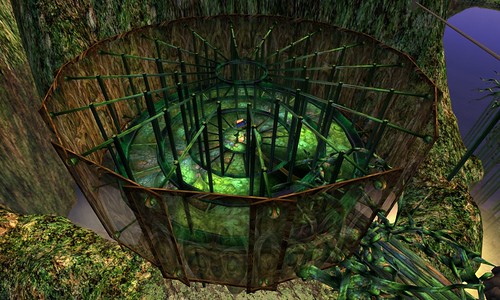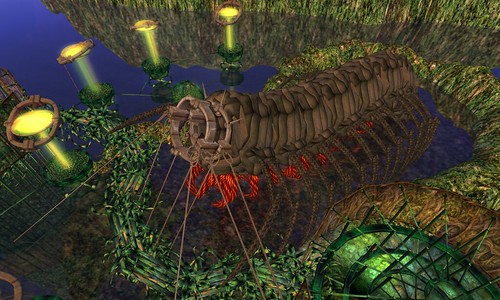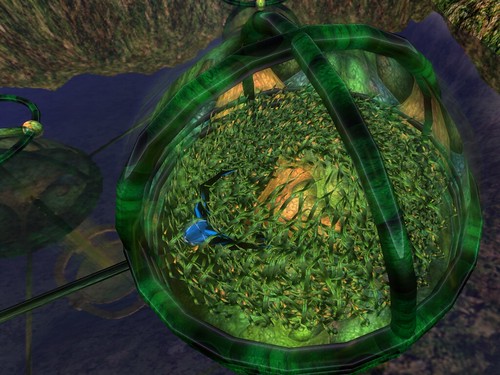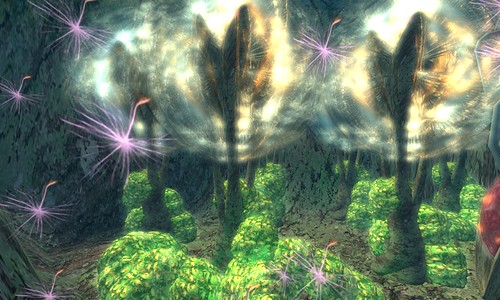The {Lost} Garden of Sundarya Lahari is one of the many LEA displays for this period, and it is striking, brilliantly colored, and gradually growing over time. I don't remember a time when over the months an LEA Exhibit has grown over time to tell the story of a lost civilizations hubris, but two months in we already have an amazing story. The textures are complicated and brilliant, but not at all naturalistic - something which fits the story and the overall style. While sometimes the unreality of textures bothers me, in this case I think the multi-layering of each part of the build mitigates that, and the complexity of the textures and the build combined is simply amazing.
There are several large, round rooms where more of these textures - rendered mostly transparent this time - make up the walls and most of the floor. In the first of these, where you'll land, is a table of books with a new part of the story available each of the five months. I'm reproducing them below as the story itself is bittersweet and lovely.
The first month was very green and had a wonderful interactive sections - one where you could walk into a myriad of tentacles and cause music to be made (I can only assume it was stunning with a crowd) and another where you could sit in a pod and watch the pentapussies as they strike multiple notes at once with their many tentacles. It's a lovely and soothing experience, especially if you manage to ctrl-click on one of the pentapussies so that you can follow it around as it bounces through the tentacles making music - though the way they move can be a little vertigo-inducing. You actually don't have to be inside of one of the pods if you move your camera inside, the seat just sets your view for you. I spent a long simply trained on one of the pentapussies, enjoying the random and melodic music while I did other things. Other times I cammed through the layers of intertwining green, watching as the textures changed as they overlayed each other and caught the light in different ways.
The myth of the Ancients adds another layer to the simple beauty and musicality of the build. It describes it as a garden built by people of unimaginable ability and a desire to shape the world without, it seems, fully understanding it. Everything is discovered, and shaped, and while the outcome is lovely and beautiful, I can't help but worry about the pentapussies suspended high above the water on delicate and improbably thin stilts. What's odd, and confusing, and disturbing and lyrical all at once are the vines which grow here and there and form the pathways between the different garden areas. They are not at all leaflike, which adds to the dis-ease, and they seem to grow in these discrete rings which is also very different from the chaotic, uneven growth I'm used to. All in all it is lovely, and walks a line between soothing and disturbing which is unusual in my experience.
The Second Month adds the first error to the story - and adds a new color scheme, greyish-brown and scarlet, along with an intrusion of violence to the garden. In a hurry and a shock the Ancients slaughtered the mother of the very creatures they had been adoring; mistaking her seeking out her children, they rendered her no more - and it's strongly implied she is one of the only mothers of its kind. Machinery keeps her alive, and the effect is ...held up by enormous metal rings and cables, the headless mother conceals a hidden passageway into the depths, where her progeny exist in many different stages, from apparent piles of eggs surrounding underwater dandelion puffs all the way to full pentapussies. It's unclear if there is, or what is, the father of all of these creatures - it's possible they could be hermaphroditic, but it seems unlikely. This sections doesn't so clearly have a musical component, but there is significantly more movement down under the water, once you find your way under the water, following secrets.
The more I reflect on it, the more I feel like there are echoes of The Ones Who Walk Away from Omelas in this - the initial shine and joy that has deeper, darker, more unacceptable underpinnings. I don't know if that's accurate, or if it's my inherent distrust of things which seem entirely pure and good that drives this comparison, but I suspect in the next months we'll find out.
First Month
According to myths, the Ancients discovered a botanical species; a kind of reed that was capable of resonating a sound frequency when touched. The Ancients harvested these reeds and created a meditative and spiritual garden.Quite by accident, the Ancients also discovered a symbiotic creature to the reeds; which they named the Pentapuss. The Pentapuss has the same form and biological structure as the reeds, and fed off the soundwaves made by the reeds. In doing so, their movements amongst the reeds nurtured the growth of the reeds to maturity.
The Ancients built BioPods and BioSpheres; to nurture these reeds and the young, juvenile pentapussies. They built contemplative Elemental pods at the Chamber of the Ancients, to observe these creatures and plants. They built a music chamber, where they can physically interact with the reeds......
In time, the garden grew to become a beautiful space - to contemplate and be as one with the beings that surrounds them.
About the Build
The build is based on live sampling of my cello "plucking". Each "reed" in the build, upon collision, produces a specific note.
The build is made up of two chambers on two towers:
1. An interactive chamber where avatars can move around, collide with the reeds and make their own music.
2.The main chamber; where the musical notes are being produced in a total unstructured fashion by the random collision of the creatures "the pentapuss". The creatures move/dance in an absolute random algorithm and upon collision with the reeds, the reeds produces the sound of a single note. Being executed in a completely random fashion, a musical score is created that is ever-changing and evolving... never the same.
Resonant sounds/notes are produced when two notes are simultaneously struck.
The beauty of the build is how one can discover an evolution in music, made totally in a random algorithm, given a full pentatonic scale (via the sounds produced on a cello).
Second Month
…..and so the story was told; that many moons had passed, and the Ancients had built their garden of tranquility - a place of musical beauty providing solace and much enjoyment.A wondrous creature rose from the waters one day. With fear in their hearts and in haste, the Ancients captured and killed the “beast”.
The Ancients realised, that in their foolish haste, they had killed the mother to the creatures they had so lovingly nurtured, and that Mother had only arisen from the depth of the blue waters to the call of her younglings.
So the Ancients built the Mechanicum - to keep mother alive so that her species live on……
About the Build
The immersive “treat” is underwater - The plant-like structure emits particle spores, and upon approach or when a Pentapuss is near, the larvaes “hide” and get “petrified” within the egg-like structure of the plants.
Third Month
Available in AprilForth Month
Available in MayFifth Month
Available in June( More pictures here. )






No comments:
Post a Comment